|
|
 |
|
|
|
Click on any photo to see a larger version
|
|
|
Façade -- an Entertainment
Conceived and Directed by Dudley Brooks
Music: Sir William Walton
Poetry: Dame Edith Sitwell
|
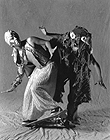
|
|
|
|
|
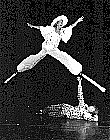
|
Choreography (original production) by
Dudley Brooks, Matthew Child,
Rose Gray, Sandra Feusi, Aidan O'Shea,
Wendy Parkman, and Terry Sendgraff
|
|
|
|
|
 A two-headed cube on a skateboard, a giant stalk of
celery in a pink dress, and a headless stiltwalker who bounds and bounces slowly through the air while her head is brought to her on a computer-controlled platter are just a few of the dancers in Façade -- an
Entertainment, a humorous surrealistic dance performed on trapeze, bungee cords, stilts, and skateboards, by a cast of child and adult dancrs and circus artists. A two-headed cube on a skateboard, a giant stalk of
celery in a pink dress, and a headless stiltwalker who bounds and bounces slowly through the air while her head is brought to her on a computer-controlled platter are just a few of the dancers in Façade -- an
Entertainment, a humorous surrealistic dance performed on trapeze, bungee cords, stilts, and skateboards, by a cast of child and adult dancrs and circus artists.
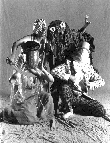 Façade is a 40-minute dance, in 21 short sections, in an
abstract, cartoonish, surrealistic style. It is a collaboration between four choreographcrs, a circus artist, a visual artist, and a computer chip designer, known in their fields for their
unique and novel investigations. It is performed to the memorably humorous 1921 music of William Walton, modernistic, but based on popular dance hall styles of the
era. The music in turn is a setting of the brilliantly colored, technically virtuosic poetry of Edith Sitwell. Façade is a 40-minute dance, in 21 short sections, in an
abstract, cartoonish, surrealistic style. It is a collaboration between four choreographcrs, a circus artist, a visual artist, and a computer chip designer, known in their fields for their
unique and novel investigations. It is performed to the memorably humorous 1921 music of William Walton, modernistic, but based on popular dance hall styles of the
era. The music in turn is a setting of the brilliantly colored, technically virtuosic poetry of Edith Sitwell.
THE POETRY
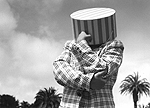 In 1921, British poet Edith Sitwell wrote a suite of short, abstract, surrealistic poems, in which "as on the
border between waking and dreaming, new landscapes would show with a brief but memorable vividness, and strange glimpses of fate, of mortals and of immortals, could be captured within the worlds of a
minute or two minutes." In 1921, British poet Edith Sitwell wrote a suite of short, abstract, surrealistic poems, in which "as on the
border between waking and dreaming, new landscapes would show with a brief but memorable vividness, and strange glimpses of fate, of mortals and of immortals, could be captured within the worlds of a
minute or two minutes."
|
|
|
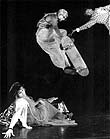
|
Edith Sitwell herself has said "The poems in Facade are abstract poems -- that is, they are patterns in
sound. They are, too, in many cases, virtuoso exercises in technique of an extreme difficulty." Many of the images are suggested by the sounds of the words:
"Though their fair hair
Shines there
Like gold-haired planets, Calliope, Io,
Pomona, Antiope, Echo, and Clio."
|
|
|
|
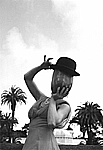 But while the poems are abstract and without plots, Sitwell
says "some of these poems are about materialism and the world crumbling into dust, some have as protagonists shadows or ghosts, moving in a highly mechanized universe.
Some of the poems have a violent exhilaration, others have a veiled melancholy, a sadness masked by gaiety." The poems use greatly exaggerated metaphors: "Pearl ropes" [of rain] "let
down from the clouds ring the hard, cold bell-buds" [of flowers] on "swan-bosomed" [covered with white blossoms] trees, while people
like "tall pagodas" walk beside "the wan, grassy sea." And there are recurring characters, mixing everything from classical mythology and the Bible, through
Commedia del Arte, to modern (1921) history, spiced with the familiar denizens of fairy tales and nursery rhymes. Queen Victoria and Alfred, Lord Tennyson,
riding on waves like rocking horses, see Venus arising from the sea, while Jumbo the Elephant, Il Capitaneo, Pan and Silenus, nymphs and satyrs, Noah, Robinson
Crusoe, William Tell, and Mrs Cow cavort with assorted nursemaids and Admirals. But while the poems are abstract and without plots, Sitwell
says "some of these poems are about materialism and the world crumbling into dust, some have as protagonists shadows or ghosts, moving in a highly mechanized universe.
Some of the poems have a violent exhilaration, others have a veiled melancholy, a sadness masked by gaiety." The poems use greatly exaggerated metaphors: "Pearl ropes" [of rain] "let
down from the clouds ring the hard, cold bell-buds" [of flowers] on "swan-bosomed" [covered with white blossoms] trees, while people
like "tall pagodas" walk beside "the wan, grassy sea." And there are recurring characters, mixing everything from classical mythology and the Bible, through
Commedia del Arte, to modern (1921) history, spiced with the familiar denizens of fairy tales and nursery rhymes. Queen Victoria and Alfred, Lord Tennyson,
riding on waves like rocking horses, see Venus arising from the sea, while Jumbo the Elephant, Il Capitaneo, Pan and Silenus, nymphs and satyrs, Noah, Robinson
Crusoe, William Tell, and Mrs Cow cavort with assorted nursemaids and Admirals.
THE MUSIC
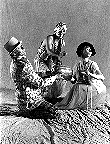 Twenty-one of these poems were set to music by William Walton, who was then a l9-year-old music student living
with the Sitwells. Walton was greatly interested in the modern music of his time, but he was also an arranger for the Savoy Orpheans, the most popular British dance band of the
Twenties. And so the chamber ensemble of six instruments plays the familiar rhythms or the foxtrot, the music hall song, circus music, Spanish dance, the tarantella, and the tango, as Twenty-one of these poems were set to music by William Walton, who was then a l9-year-old music student living
with the Sitwells. Walton was greatly interested in the modern music of his time, but he was also an arranger for the Savoy Orpheans, the most popular British dance band of the
Twenties. And so the chamber ensemble of six instruments plays the familiar rhythms or the foxtrot, the music hall song, circus music, Spanish dance, the tarantella, and the tango, as
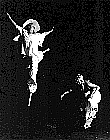 well as dissonant, angular pieces and quieter, more lyrical sections. well as dissonant, angular pieces and quieter, more lyrical sections.
The words and music are so well integrated that, for anyone who has listened to the work, it is impossible to hear the
poetry being recited without imagining the music, or to hear Walton's concert version of the music without remembering the words.
THE DANCE
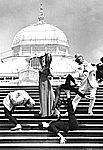 Early performances of Façade emphasized its abstractness by
placing all the performers behind a curtain, with only a megaphone through which the reciter's voice was heard. The dance production is similarly abstract, even cartoonish. The
several artists who have been asked to contribute the individual sections were given no requirement other than "no human beings should appear." And so in the Tarantella, for
example, whose poetry uses the imagery of classical mythology to give a sense of fecundity and uncontrolled exhuberance, we have
robots and radio-contolled trucks carrying fruits and vegetables and hurling tomatoes at each other, while for other poems invisible jugglers manipulate black
light objects. A Creature From the Id bursts into flame from its own anger, a pair of fisherman's boots mistake each other for fish, and a giant stalk of celery in
a pink dress performs Farcical Vegetable Dancing (her specialty) with her Cornucopian Cantaloupe Companions. Early performances of Façade emphasized its abstractness by
placing all the performers behind a curtain, with only a megaphone through which the reciter's voice was heard. The dance production is similarly abstract, even cartoonish. The
several artists who have been asked to contribute the individual sections were given no requirement other than "no human beings should appear." And so in the Tarantella, for
example, whose poetry uses the imagery of classical mythology to give a sense of fecundity and uncontrolled exhuberance, we have
robots and radio-contolled trucks carrying fruits and vegetables and hurling tomatoes at each other, while for other poems invisible jugglers manipulate black
light objects. A Creature From the Id bursts into flame from its own anger, a pair of fisherman's boots mistake each other for fish, and a giant stalk of celery in
a pink dress performs Farcical Vegetable Dancing (her specialty) with her Cornucopian Cantaloupe Companions.
|
|
|
|